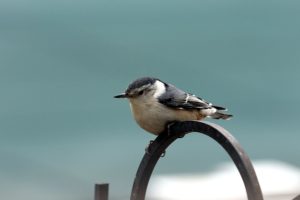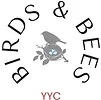
Year-Round Residents
As we start to see migrating birds return to Alberta, we take a few minutes to talk about a year-round resident, the Nuthatch. They get their common name from their habit of jamming large nuts and acorns into tree bark, then whacking them with their sharp bill to “hatch” out the seed from the inside. Nuthatches are strictly a northern-hemisphere group. There are many species in Europe and Asia: there is even one that specializes in finding bugs on rocks rather than trees—the Western rock nuthatch.
Upside Down Birds
Nuthatches don’t rely on their tail feathers like Woodpeckers to prop themselves against the trunk while foraging for insects. Instead Nuthatches have a large claw on their one backward-pointing toe that helps them keep a grip. Why forage downward, head first, instead of backing down the trunk? The different position from Woodpeckers and other birds allows Nuthatches to capitalize on insects and other invertebrates seen only from the upside-down viewpoint. WB breeding pairs may smear insects around the entrance as a deterrent to squirrels. *RB nuthatches will also do this. Come in to see the one we have on display
Two Varieties
The two varieties found in Alberta are Red-breasted and White-breasted. So how do you tell a Red-breasted nuthatch from a White-breasted? The most obvious answer is their size: White-breasted are the larger of the two. But there is a much easier way. The White-breasted is the only one with a white face, while the Red-breasted is the only one with a white eyebrow. Other than those two ways of distinguishing the two from each other, they are very similar.
Red-breasted nuthatches are strongly tied to small conifer cones for food. They are adept at extracting seeds from spruce cones and other small, soft cones. This, in fact, is their main over winter food and it gives them the ability to winter well north of the White-breasted nuthatch, which looks for largely insect food in bark.
Prefers Woodpecker holes (e.g. Flicker) or natural cavities. WB nuthatches will use a nest box if natural nesting sites are not available, but will resist using a nest box mounted on a pole, preferring one mounted on a mature tree.
If you enjoyed this post, we encourage you to signup for our newsletter:
Sign up for our monthly newsletter that keeps you up to date on our in store specials, monthly savings and has great articles about local birds, It also lets you know what upcoming seminars and workshops are happening in our Classroom/Gallery.
By submitting this form, you are consenting to receive marketing emails from: . You can revoke your consent to receive emails at any time by using the SafeUnsubscribe® link, found at the bottom of every email. Emails are serviced by Constant Contact
